
Senna hebecarpa, with the common names American senna and wild senna, is a species of legume native to eastern North America.

Potamogeton praelongus, commonly known as whitestem pondweed in North America and long-stalked pondweed in Britain, is a large, perennial aquatic plant in the family Potamogetonaceae. It is widely distributed in lakes and rivers in the northern hemisphere, but is sensitive to poor water quality.

Potamogeton alpinus is a species of perennial aquatic plant known by the common names alpine pondweed and red pondweed. It is widespread in the northern hemisphere in both rivers and lakes with good water quality.

Potamogeton gramineus is a species of aquatic plant known by the common name various-leaved pondweed, variableleaf pondweed, grass-leaved pondweed or grassy pondweed, native to the northern hemisphere where it grows in shallow, clean water.

Potamogeton pusillus is a species of aquatic plant known by the common names small pondweed, lesser pondweed or least pondweed. It occurs in standing and slow-flowing freshwater habitats throughout the Northern Hemisphere.

Potamogeton compressus is a species of aquatic plant known by the common names grass-wrack pondweed, flatstem pondweed and eel-grass pondweed.

Gaultheria hispidula, commonly known as the creeping snowberry or moxie-plum, and known to Micmaq tribes of Newfoundland as Manna Teaberry, is a perennial spreading ground-level vine of the heath family Ericaceae. It is native to North America and produces small white edible berries. It fruits from August to September. Its leaves and berries taste and smell like wintergreen.
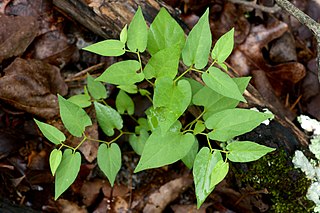
Aristolochia serpentaria is a species of perennial flowering plant in the Aristolochiaceae (birthwort) family. The species is commonly known as Virginia snakeroot and is native to eastern North America, from Connecticut to southern Michigan and south to Texas and Florida.
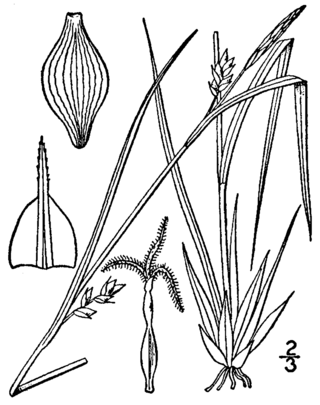
Carex oligocarpa, common name richwoods sedge, eastern few-fruited sedge, few-fruit sedge, and few-fruited sedge is a Carex species that is native to North America. It is a perennial.
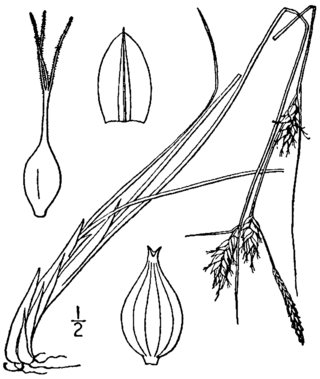
Carex oligosperma, common name fewseed sedge, few-seeded sedge, and few-fruited sedge, is a perennial plant in the Carex genus. A distinct variety, Carex oligosperma var. oligosperma, exists.
Potamogeton ogdenii, common name Ogden's pondweed, is a perennial plant native to North America.

Carex typhina, often called the cattail sedge, is a rare species of Carex known to grow in wetlands. It is native to North America.

Lipocarpha micrantha, known as dwarf bulrush, small-flowered hemicarpha, small-flower halfchaff sedge, common hemicarpa and tiny-flowered sedge, is a species of flowering plant in the sedge family (Cyperaceae) native to North America.

Rhynchospora scirpoides, also referred to as Psilocarya scirpoides; common names long-beaked beaksedge and long-beaked bald rush; is a plant in the Rhynchospora genus found in North America.

Eleocharis microcarpa, common names small-fruited spikesedge, spike-rush, small-fruited spike-rush and tiny-fruited spike-sedge, is a plant in the Eleocharis genus found in North America.

Ludwigia sphaerocarpa, common names globe-fruited false-loosestrife, globefruit primrose-willow, round-fruited false-loosestrife, globe-fruited seedbox, globe-fruited ludwigia, spherical-fruited seedbox and round-fruited false loosestrife; is a plant found in North America. It is listed as endangered in Connecticut, Indiana, Massachusetts and Rhode Island, and as threatened in Michigan and New York (state). It is listed as extirpated in Pennsylvania.
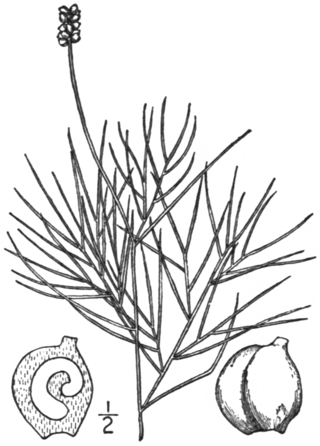
Potamogeton confervoides, common names pondweed, alga-like pondweed, algae-like pondweed, and Tuckerman's pondweed is a species of plant found in North America. It is listed as endangered in Connecticut, as a special concern in Maine, as threatened in Massachusetts, New York (state), Pennsylvania, and Wisconsin. It is listed as historical in Rhode Island.
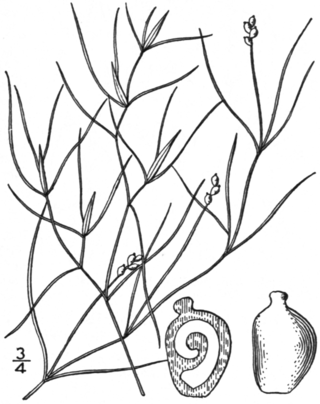
Potamogeton gemmiparus, is a species of plant found in North America. It is also known as Potamogeton pusillus var. gemmiparus, common names capillary pondweed, slender pondweed, and budding pondweed. It is listed as threatened in Connecticut and in New Hampshire, as rare in Indiana, and as a special concern in Rhode Island.
Potamogeton strictifolius, common names straight-leaved pondweed, pondweed,straight-leaf pondweed, and narrow-leaved pondweed, is a species of plant found in North America. It is listed as endangered in Connecticut, Illinois, Indiana, Massachusetts, and in New York (state). It is listed as possibly extirpated in Maine, and presumed extirpated in Ohio.

Potamogeton vaseyi, common name Vasey's pondweed, is a species of plant found in North America. It is listed as an endangered species in Indiana, Massachusetts, and Pennsylvania, and is listed as threatened in Connecticut, Maine, Michigan, and New Hampshire, and as presumed extirpated in Ohio.


















